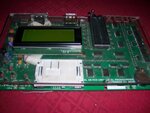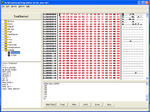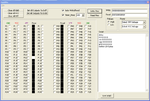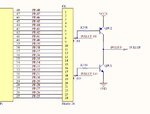picman100
Junior Member level 2

Hi, i have designed a 48 pin universal programmer but need help finishing it off, is anyone up for the challange?
Programmer info:
LPC2388 ARM7TDMI CPU with USB
2XDC/DC Converters
48 universal pin drivers which can be either GND/VCC/VPP/HI,LO/CLOCK/INPUT
Smart card interface
ISP socket which is used for JTag for FPGA's/CPLD/ARMs Anything JTag... /serial programming devices mounted on a board Pic's/AVR's etc/In car Dashboards/ECU's etc
USB Interface
Ethernet Interface
SD card
LCD
Serial interface
Buttons/switches lights etc
JTAG For ARM
JTAG for FPGA
Soft JTAG for FPGA

This is really a massive project and has taken me a while to get this far, i think i need help to finish it.
The software is written in delphi:


USB Uses CDC So can be used on any PC.
So far i can read and write to all pins fine, program the FPGA, etc
There are three parts to the programmer.
Firmware:
Written in C using Keil compiler.
FPGA:
Designs are done in Altium.
PC Software:
Written in Delphi 7
I am very good with the firmware, and not bad with the FPGA, the PC software is not good for me...
I want the software, fpga designs and the firmware to be OPEN SOURCE, this was the idea behind it, as you cannot by a good true universal programmer for less than around £500 i thought it would be a good project to undertake, with the added benefit of a smart card programmer and ISP it should be a good device, and hoping to ship it for less than £100
So if you are up for a challange let me know......
Many Thanks....
Picman....;-)
Programmer Schematics....
The PSU for VCC and VPP need changing does not work too well, but i think it would be good to only need the 5V from the USB to power the programmer, so DC/DC converters are needed to get VPP.
Programmer info:
LPC2388 ARM7TDMI CPU with USB
2XDC/DC Converters
48 universal pin drivers which can be either GND/VCC/VPP/HI,LO/CLOCK/INPUT
Smart card interface
ISP socket which is used for JTag for FPGA's/CPLD/ARMs Anything JTag... /serial programming devices mounted on a board Pic's/AVR's etc/In car Dashboards/ECU's etc
USB Interface
Ethernet Interface
SD card
LCD
Serial interface
Buttons/switches lights etc
JTAG For ARM
JTAG for FPGA
Soft JTAG for FPGA

This is really a massive project and has taken me a while to get this far, i think i need help to finish it.
The software is written in delphi:


USB Uses CDC So can be used on any PC.
So far i can read and write to all pins fine, program the FPGA, etc
There are three parts to the programmer.
Firmware:
Written in C using Keil compiler.
FPGA:
Designs are done in Altium.
PC Software:
Written in Delphi 7
I am very good with the firmware, and not bad with the FPGA, the PC software is not good for me...
I want the software, fpga designs and the firmware to be OPEN SOURCE, this was the idea behind it, as you cannot by a good true universal programmer for less than around £500 i thought it would be a good project to undertake, with the added benefit of a smart card programmer and ISP it should be a good device, and hoping to ship it for less than £100
So if you are up for a challange let me know......
Many Thanks....
Picman....;-)
Programmer Schematics....
The PSU for VCC and VPP need changing does not work too well, but i think it would be good to only need the 5V from the USB to power the programmer, so DC/DC converters are needed to get VPP.
Attachments
Last edited:




